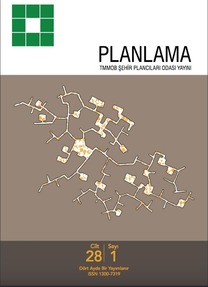Kompakt Kent Ölçütlerinden Biri Olan Yoğunluk Tespiti ve Değerlendirmesi: Türkiye Kentleri (İl Merkezleri) Örneği
Kompakt kent modeli, sürdürülebilir kentsel gelişim arayışlarında sıkça gündeme getirilen yaklaşımlardan biridir. Yaklaşımın temel amacı, yaygın gelişim nedeniyle yaşanan ekonomik, sosyal ve çevresel sorunların önüne geçmektir. Kompakt kent modelinin fonksiyonlar arası mesafelerin kısaldığı yüksek yoğunluklu yapılaşma yaklaşımı, özellikle iklim değişikliğini hafifletme hedefinde ilerleyen sera gazı azaltım politikaları bağlamında önemli bir yer tutmaktadır. Bu makalenin amacı, Türkiye kentlerinin (81 il merkezi) yerleşik alan sınırları temel alınarak, en önemli kompakt kent ölçütlerinden biri olan kentsel brüt nüfus yoğunluklarını hesaplamaktır. Bu doğrultuda öncelikle ulusal literatüre kentsel brüt nüfus yoğunlukları ve yerleşik alan büyüklüklerine ilişkin veri kazandırılması hedeflenmiştir. Makalede ayrıca kentlerin büyükşehir statüsünde olup olmamalarına göre kategorize edildikten sonra nüfus yoğunlukları, yerleşik alan büyüklükleri ve nüfusları arasındaki ilişki yönü ve şiddetine dair analizler yapılmış ve böylelikle kentlerin kompaktlık açısından değerlendirilebilmesine yönelik kullanılması gereken ölçütlerden biri olan yoğunluğa ilişkin analizler gerçekleştirilmiştir. Elde edilen sonuçlar dünya kentleri ile karşılaştırmalı değerlendirildiğinde, ülkemizdeki kentlerin yüksek brüt nüfus yoğunluklarına sahip olduğunu ve sadece nüfus yoğunluğu kriteri gözetildiğinde, genel olarak, kompaktlık kriterlerinden birini sağlayan bir profil çizdiğini göstermektedir.
Determining and Assessing the Urban Density which is One of the Compact City Parameters: Case of Turkey Cities
Compact urban settlement is one of the approaches that has been often discussed in the search for sustainable urban development. The main aim of the approach is to prevent economic, social, and environmental problems caused by urban sprawl. The compact urban model’s high-density build-up approach plays an important role in the context of greenhouse gas reduction policy that is particularly targeted at mitigating climate change by shortening the distances between functions. The purpose of the present study, on the basis of built-up area boundaries of the cities in Turkey (81 cities), was to calculate the urban gross population density which is one of the most important compact city parameters. In this context, first, the present study aimed to provide data to the national literature on urban gross population densities and built-up area sizes. Cities were also categorized according to whether they are in metropolitan municipality status or not, and the strength and direction were calculated with the correlation analysis between population, population density, and built-up area size, and thus population density, which should be used for the evaluation of cities with respect to compactness, analysis was conducted. The cities in our country have high gross population densities compared with world cities, and generally, considering only the population density parameter, they show a profile that provides one of the criteria for compactness.
___
- Aydın, M.B.S. (2015). İklim Değişikliği Sorununda Kent ve Kentsel Planlama. Yalın Yayıncılık: İstanbul.
- Burgess, R. (2000). The compact city debate: A global perspective. In Compact Cities: Sustainable Urban Forms for Developing Countries. ( Jenks, M., Burgess, R. ed.). Spon Press, London and New York, ss.9-24.
- Burton, E. (2000). The compact city: Just or just compact? A preliminary analysis. Urban Studies. Vol. 37, No. 11, 1969– 2001.
- Burton, E. (2002). Measuring urban compactness in UK towns and cities. Environment and Planning B: Planning and Design, vol.29, 219-250.
- Carmona, M. (2000). The regional dimension of the compact city dabate: Latin America. In Compact Cities: Sustainable Urban Forms for Developing Countries. ( Jenks, M., Burgess, R. ed.). Spon Press, London and New York, ss. 53-62.
- Demograpia. (2018). Demographia World Urban Areas (Built up Urban Areas or World Agglomerations). 14th Annual Edition. http://www.demographia.com/db-worldua.pdf
- Galster, G., Hanson, R., Ratcliffe, M.R., Wolman, H., Coleman, S., Freihage, J. (2001) Wrestling sprawl to the ground: Defining and measuring an elusive concept. Housing Policy Debate, 12(4), 681-717.
- George, D., Mallery, M. (2010). SPSS for Windows Step by Step: A Simple Guide and Reference, 17.0 update (10a ed.) Boston: Pearson
- Gordon, P., Richardson, H.W. (1997). Are compact cities a desirable planning goal? Journal of the American Planning Association, 95-106.
- Jabareen, Y.R. (2006). Sustainable urban forms: Their typologies, models, and concepts. Journal of Planning Education and Research, 26, 38-52.
- Kenworthy, J.R. (2006). The eco-city: ten key transport and planning dimensions for sustainable city. Environment and Urbanization, 18 (1), 67-85.
- Kotharkar, R., Bahadure, P., Sarda, N. (2014). Measuring Compact Urban Form: A Case of Nagpur City, India. Sustainability, 6, 4246-4272.
- Lee, J., Kurisu, K., An, K., Hanaki, K. (2015). Development of the compact city index and its application to Japanese cities. Urban Studies, 52(6), 1054-1070.
- Lin J-J., Yang A-T (2006) Does the compact city paradigm foster sustainability? An empirical study in Taiwan. Environment and Planning B: Planning and Design, 33(3), 365–380.
- Min C., Suxia L., Liang Y. (2012) Calculation and Analysis of Urban Compactness Using an Integrated ARCGIS Tool. In: Zhang Y. (eds) Future Wireless Networks and Information Systems. Lecture Notes in Electrical Engineering, vol 144. Springer, Berlin, Heidelberg.
- Neuman, M. (2005). The compact city fallacy. Journal of Planning Education and Research. 25, 11-26.
- Richardson, H.W., Bae, C.H.C, Baxamusa, M.H. (2000). Compact cities in developing countries: Assesment and implications. In Compact Cities: Sustainable Urban Forms for Developing Countries. ( Jenks, M., Burgess, R. ed.). Spon Press, London and New York, ss.25-36.
- Terzi, F., Bolen, F. (2009). Urban Sprawl Measurement of Istanbul. European Planning Studies, 17:10, 1559-1570.
- Tosun, E.K. (2013). Sürdürülebilir kentsel gelişim sürecinde kompakt kent modelinin analizi. Yönetim ve Ekonomi. 20 (1), 31-46.
- Tsai, Y. (2005). Quantifying urban Form: Compactness versus ‘sprawl’. Urban Studies, 42(1), 141-161.
- Van der Walls, J.F.M. (2000). The compact city and the environment: a review. Tijdschrift voor Economische en Sociale Geografie, 91 (2), 111-121.
- ISSN: 1300-7319
- Yayın Aralığı: Yılda 3 Sayı
- Başlangıç: 1986
- Yayıncı: TMMOB Şehir Plancıları Odası
Sayıdaki Diğer Makaleler
Kent Hakkı ve Katılımcılık Bağlamında Kendin Yap Kentleşme: Roma Bostanı Örneği
Turistik Mekânda Gerçekliğin Algısal Değişimi: Modern ve Post-Modern Turizm Deneyimlerinde Özgünlük
Mekanın Biçimlenişi ve Kentsel Karakterin Oluşumu; İzmir (Kemeraltı) Örneği
Yerel Demokrasi Arayışında Mahalle Yönetimi
